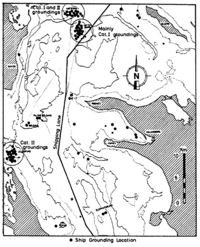Difference between revisions of "Predicting Grounding Frequencies"
(New page: == Introduction == {{Theory_Source_PFH}} Category:Theory) |
|||
| Line 1: | Line 1: | ||
== Introduction == | == Introduction == | ||
Following Pedersen [25], the grounding scenarios may broadly be divided into four main categories, see Figure 10: | |||
{| | |||
I.|Ships following the ordinary direct route at normal speed. Accidents in this category are mainly due to human error, but may include ships subject to unexpected problems with the propulsion/steering system that occur in the vicinity of the fixed marine structure or the ground. | |||
|-II.|Ships that failed to change course at a given turning point near the obstacle. | |||
|-III.|Ships taking evasive actions near the obstacle and consequently run aground or collide with the object. | |||
|-IV.|All other track patterns than Cat. I, II and III, for example ships completely out of course due to loss of propulsion. | |||
|} | |||
[[Image:20090405 Fig10.jpg|200px]] | |||
Figure 10 shows observed grounding locations in a part of the Great Belt in Denmark over a 15-year-period. | |||
It is seen that most of the grounding events belong to category I and II, but there are also category III and IV groundings which seem to be randomly scattered over the area. | |||
In formulating a theoretical model for the grounding scenario it is expedient to divide the grounding scenario into powered groundings and drifting groundings. Such division eases not only the frequency assessment but also the pursuing consequence assessment. | |||
Revision as of 15:13, 5 April 2009
Introduction
Following Pedersen [25], the grounding scenarios may broadly be divided into four main categories, see Figure 10:
I.|Ships following the ordinary direct route at normal speed. Accidents in this category are mainly due to human error, but may include ships subject to unexpected problems with the propulsion/steering system that occur in the vicinity of the fixed marine structure or the ground.Figure 10 shows observed grounding locations in a part of the Great Belt in Denmark over a 15-year-period.
It is seen that most of the grounding events belong to category I and II, but there are also category III and IV groundings which seem to be randomly scattered over the area.
In formulating a theoretical model for the grounding scenario it is expedient to divide the grounding scenario into powered groundings and drifting groundings. Such division eases not only the frequency assessment but also the pursuing consequence assessment.
|
Source: IWRAP Mk II, Basic Modelling Principles for Prediction of Collision and Grounding Frequencies, (draft working document), Rev. 4, 2008.03.09, Peter Friis-Hansen, Technical University of Denmark. |
